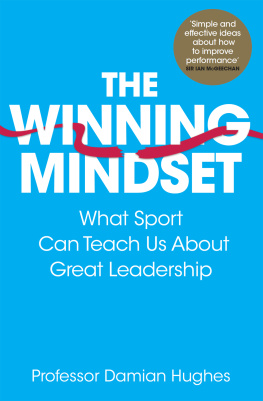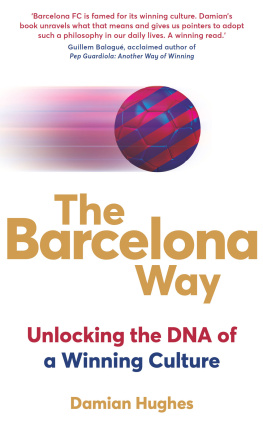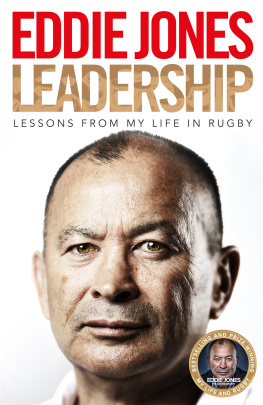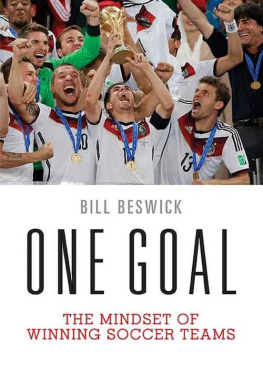DAMIAN HUGHES
THE WINNING MINDSET
What Sport Can Teach Us About Great Leadership
PAN BOOKS
Contents
PROLOGUE
Ringside in San Remo, Milan, 1996.
WBC World Super-Middleweight title fight.
Crouched down in the challengers red corner, I watched the action intently as the ever fiercer left hooks of Runcorns Robin Reid continued to swing and connect with the Italian champion, the redoubtable Vincenzo Nardiello. Whenever Reid made an impression, I noted that he immediately skipped away from the champions flailing retort and evaded the shot. I watched his trainer, Brian Hughes, who himself watched the proceedings with a silent intensity that enthralled me.
Id read about the state of flow defined by the wonderfully named psychologist Mihaly Csikszentmihalyi (pronounced six-cent-mihaly) as the place where mind and body work in harmony to produce their optimum performance and I watched him completely in sync with the action, anticipating events seconds before they happened. His game plan, prepared after hour upon endless hour in front of video footage and then repeated in the dusty old gym where he had presided for my whole life, had now taken its physical form and he watched for any slight insights where he could tinker and adapt.
Ten seconds, I offered. This was the signal for the corner to become the boxing equivalent of a Formula One pit crew, busily applying fluids, respite, direction and advice in their minute-long intervention. My voice was loud enough to rise above the raucous Milanese crowd, urging their hometown hero to victory, but I was mindful of the mantra which had been drilled into me over the years: Keep your voice calm and your body language still during the fight. You need to present an image of complete control because it can panic the fighter. Brian Hughes had been learning his craft as master coach since he was a boy and these insights always came packed with common sense hewn from years of experience. Listening to his wisdom, presented with a mix of gruffness and enthusiasm delivered in the kind of accent and phraseology that seems to have stepped straight from the pages of an Alan Bennett script, is one of lifes pleasures, was how the Daily Telegraph once described his instruction.
I played through the different instructions he could offer to Reid, who was coming back to the corner and gulping oxygen into his lungs. There were only sixty seconds to deliver the message, so it needed to be concise. Reid could be instructed to increase the pace of the fight, trusting his superior conditioning to take effect in the later rounds. He could receive a torrent of encouragement for executing the plan so diligently. How about a warning not to get complacent? The easiest option would be to remind him to keep on doing what he was doing. Why rock the boat? Why disrupt a winning plan? I moved closer to listen to the instructions, delivered in just five words.
Sit down when you punch.
Sit down when you punch. I knew exactly what he meant because of the simplicity and the clear image in my head which it evoked. The plan had been to throw punches whilst the legs identified their escape route. Sitting down was a change of plan. It meant stillness as opposed to speed.
He had seen that the punches were hurting but that his fighter was preparing to move away as the punches landed, reducing the power each punch contained. The instruction to sit down suggested that, rather than look to move, Reid should plant both feet, increasing the leverage and the associated power of a punch, as Hughes had seen that Vincenzo Nardiellos resistance was falling fast.
Most importantly, Reid understood it too. He nodded his understanding, stood up, adjusted his shorts, punched his gloves together to indicate his readiness to continue and stepped back into the centre of the rings canvas for the seventh round of the WBC World Super-Middleweight title fight, the most prestigious of the alphabet titles which confusingly littered the sport.
Two minutes and fifty-nine seconds later, I scrambled into the ring to celebrate a victory for Reid and Brian Hughes, my dad, who had become the first Manchester man in fifty years to train a world champion.
INTRODUCING THE FIVE STEPS
Sport as an industry is unique in the breadth of its appeal, the scale of its support and its ability to generate emotion. For generations, it has created extraordinary memories, offering us visions of sublime skill and moments of great passion. It has also generated pain and anguish. Across the world, it both divides and unites people of different races, nationalities and every conceivable status. It is sport which binds workers and rulers, children and the elderly.
Professional sport is, therefore, a crucible. The people working inside that crucible, charged with the task and privilege of leading sports teams, are generally known as the managers. In fact, their role has only a little to do with management, and much more to do with leadership. Those that do this in the upper reaches of sport are truly extraordinary. The work they perform is intensive, personal, technical and critical critical to the success of their teams, the growth of their sport, and the happiness of many. It is also subject to intense personal scrutiny: their every move whether witnessed, surmised or merely imagined is subject to widespread analysis in almost every forum imaginable, from bar rooms through offices to Internet blogs and live television or radio broadcasts. They have their leadership publicly examined, challenged, lauded and ridiculed on a daily basis. Some of us feel we could do a better job if asked. Others stand back in admiration of the great achievers, and cast a sympathetic backward glance at the ones who look like theyve failed. But we actually have very little appreciation of the full scope of their work.
The role of a sports team leader is fascinating, complex and tough. Fantasy football leagues may convince us that its about buying players and selecting a team. In reality it is about creating winning environments, recruiting, developing and nurturing talent, effectively communicating a shared vision with a diverse collection of individuals, delivering on enormous expectations from a range of stakeholders, overcoming significant challenges, handling pressure and staying focused throughout a set of challenges familiar to leaders in all sectors.
The aim of this book is to distil the lessons I have accumulated in my own work as an adviser to sporting and business leaders, enabling them to create winning cultures in sports as diverse as international and domestic rugby league, Premier League football, rugby union, athletics, water polo, swimming, diving, professional boxing, squash, golf and Australian Rules Football, where I have soaked up information about creating a winning mindset. This book is me wringing myself out. This is not to say that one leader has all the answers or even that a full cohort has cracked it between them. But there is a set of circumstances from which emerges a compelling language, one of creating a winning mindset, that will be useful to leaders in any and every setting.
HOW TO APPLY IT?
The broad question, then, is how do you create a winning mindset?
During my visits, and in working with great and equally illuminatingly, not-so-successful coaches, I have begun to see the same themes, the same attributes, reflected in a wide range of successful environments. What I found was that their ideas shared certain key traits. There is no formula for a winning culture I dont want to overstate the case. But these cultures do draw on a common set of traits, which make them more likely to succeed.











